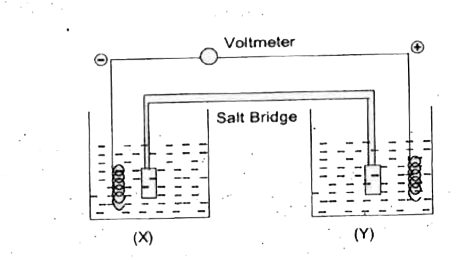The following electrochemical cell is represented as
If an ammeter is connected between two platinum electrodes, predict the direction of flow of current.
Will the current decrease or increase with time?
Given
To solve the problem, we will analyze the electrochemical cell step by step.
Step 1: Identify the components of the cell.
The cell is represented as:
Pt(1)|Hg2+,Hg2+2(a=1)||Ce4+,Ce3+(a=1)|Pt(2)
Here, we have:
- Anode: Left side (where oxidation occurs)
- Cathode: Right side (where reduction occurs)
Step 2: Determine the half-reactions.
- At the anode (left side), the half-reaction is:
Hg2+2+2e−→2Hg
(This is oxidation, as Hg2+2 is being converted to Hg.)
- At the cathode (right side), the half-reaction is:
Ce4++e−→Ce3+
(This is reduction, as Ce4+ is being converted to Ce3+.)
Step 3: Determine the direction of current flow.
- The current flows in the opposite direction to the flow of electrons. Since electrons flow from the anode (where oxidation occurs) to the cathode (where reduction occurs), the current will flow from the cathode to the anode.
Step 4: Analyze the change in current over time.
- The current will not decrease or increase with time because the concentrations of the reactants and products are constant (given a=1 for both half-cells). The cell potential is positive (E∘cell=0.69V), indicating that the reaction is spontaneous and will continue at a steady rate.
Final Answers:
a. The direction of flow of current is from the cathode (Ce side) to the anode (Hg side).
b. The current will remain constant over time.
The cell is represented as:
Pt(1)|Hg2+,Hg2+2(a=1)||Ce4+,Ce3+(a=1)|Pt(2)
Here, we have:
- Anode: Left side (where oxidation occurs)
- Cathode: Right side (where reduction occurs)
- At the anode (left side), the half-reaction is:
Hg2+2+2e−→2Hg
(This is oxidation, as Hg2+2 is being converted to Hg.)
Ce4++e−→Ce3+
(This is reduction, as Ce4+ is being converted to Ce3+.)
- The current flows in the opposite direction to the flow of electrons. Since electrons flow from the anode (where oxidation occurs) to the cathode (where reduction occurs), the current will flow from the cathode to the anode.
- The current will not decrease or increase with time because the concentrations of the reactants and products are constant (given a=1 for both half-cells). The cell potential is positive (E∘cell=0.69V), indicating that the reaction is spontaneous and will continue at a steady rate.
a. The direction of flow of current is from the cathode (Ce side) to the anode (Hg side).
Topper's Solved these Questions
- BOOK - CENGAGE CHEMISTRY ENGLISHCHAPTER - ELECTROCHEMISTRYEXERCISE - Solved Examples (Electrochemical Cell)36videos
ELECTROCHEMISTRY
- BOOK - CENGAGE CHEMISTRY ENGLISHCHAPTER - ELECTROCHEMISTRYEXERCISE - Solved Examples(Electrolysis And Electrolytic Cells)12videos
ELECTROCHEMISTRY
- BOOK - CENGAGE CHEMISTRY ENGLISHCHAPTER - D AND F BLOCK ELEMENTSEXERCISE - Archives Subjective29videos
D AND F BLOCK ELEMENTS
- BOOK - CENGAGE CHEMISTRY ENGLISHCHAPTER - GENERAL PRINCIPLES AND PROCESS OF ISOLATION OF ELEMENTSEXERCISE - Archives (Subjective)14videos
GENERAL PRINCIPLES AND PROCESS OF ISOLATION OF ELEMENTS
Similar Questions
The following electrochemical cell has been set up.
Pt(I)∣∣Fe3+,Fe2+(c=1)∣∣∣∣Ce4+,Ce3+(c=1)∣∣Pt(II)
EFe3+/Fe2+=0.77V and E∘Ce4+/Ce3+=1.61V
If an ammeter is connected between the two platinum electrode, predict the direction of flow of current. Will the current increase or decrease with time ?View SolutionIf the bisector of the angel C of a triangle ABC cuts AB in D and the circumcircle E, prove that CE:DE=(a+b)2:c2
View Solution(a) How many mole of mercury will be produced by electrolysing 1.0 M Hg (NO3)2 solution with a current of 2.00 A for 3 hours? [Hg(NO3)2=200.6gmol−1].
(b) A voltaic cell is set up at 25∘C with the following half-cells Al3+ (0.001M) and Ni2+ (0.50M). Write an equation for the reaction that occurs when the cell generates an electric current and determine the cell potential.
(Given : E2Ni2+/Ni=−0.25V,E∘Al3+/Al=−1.66V)View SolutionGalvanic cells generate electrical energy at the expense of a spontaneous redox reaction. In an electrode concentration cell two like electrodes having different concentrations, either because they are gas electrodes operating at different pressures or because they are amalgams (solutions in mercury) with different concentrations are dipped into the same solution.
Eg. An example is a cell composed of two chlorine electrodes with different pressure of Cl2:
PtL|Cl2(PL)|HCl(aq)|Cl2(PR)|PtR
Where PL and PR are the Cl2 pressure at the left and right electrodes.
Calculate the EMF of the electrode concentration cell represented by :
Hg−Zn(c1)∣∣Zn+2(aq)∣∣Hg−Zn(c2)
At 25∘C.c1=2g of Zn per 100g of Hg and c2=1g of Zn per 50g of HgView SolutionCalculate pH of the half cell :
Pt,H2(1atm)∣H2SO4 Ec−=−0.3VView SolutionCalculate the electrode potential of given electrode
Pt,Cl2 (1.5 bar) 2Cl−(0.01M),E∘Cl2/2Cl−=1.36VView SolutionThe cell Pt∣H2(g,01 bar) ∣∣H+(aq),pH=x∣∣∣∣Cl−(1M)∣∣Hg2Cl2|Hg|Pt has emf of 0.5755 V at 25∘C the SOP of calomel electrode is −0.28V then pH of the solution will be
(a)11
(b)4.5
(c)5
(d)None of theseView SolutionArrange Ag, Cr and Hg metals in the increasing order of reducing power. Given :
E∘Ag+/Ag=+0⋅80V
E∘cr+3/Cr=−0⋅74V
E∘Hg+2/Hg=+0⋅79VView SolutionThe cell potential for the unbalanced chemical reaction:
Hg2+2+NO−3+H3O+→Hg2++HNO2+H2O+e−

Is measured under standard conditions in the electrochemical sell shown in the diagram were
Equilibrium constant for cell reaction is :View SolutionThe values of some of the standard electrode potential are
E∘(Ag+/Ag)=0.80V,E∘(Hg2+21+/Hg)=0.79VE∘(Cu+2/Cu)=0.34V
What is the sequence of deposition of metals on the cathode ?View Solution

